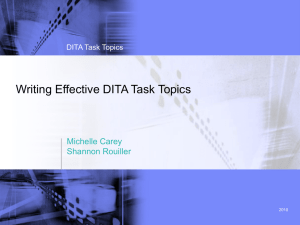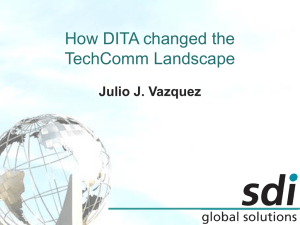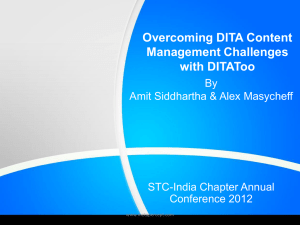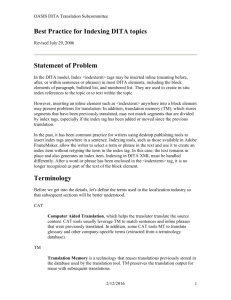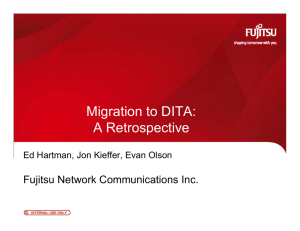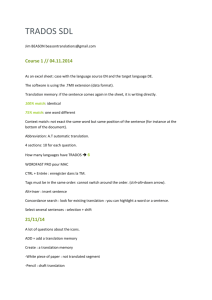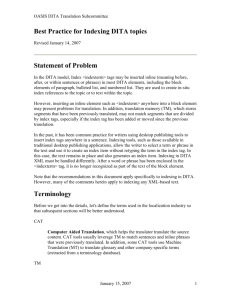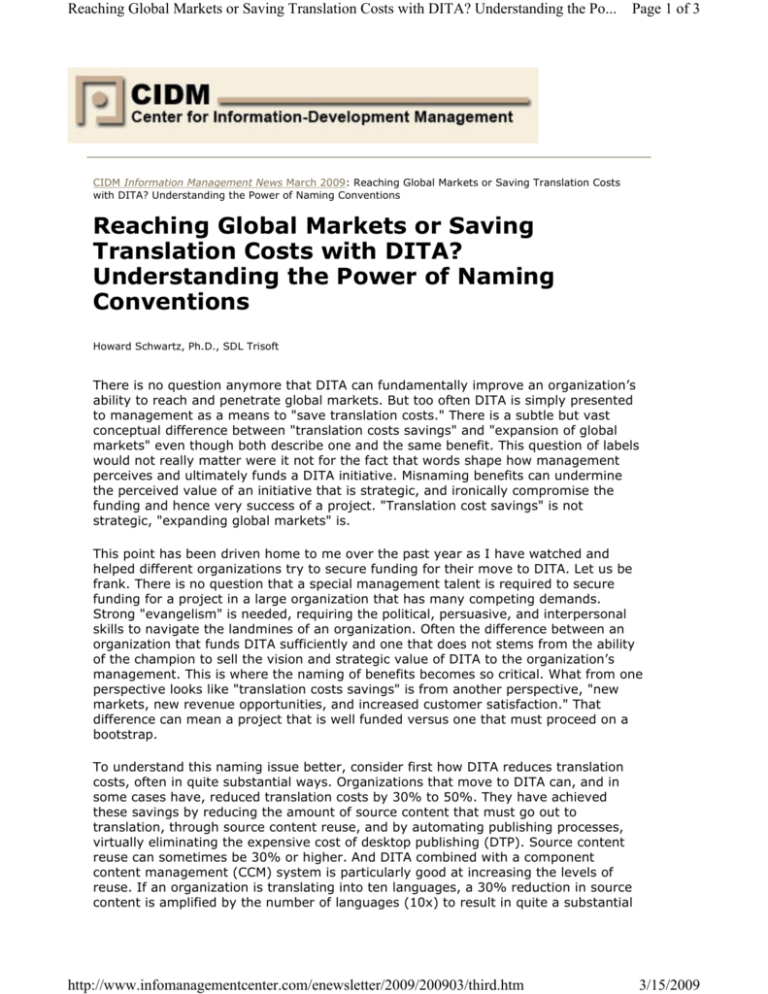
Reaching Global Markets or Saving Translation Costs with DITA? Understanding the Po...
Page 1 of 3
CIDM Information Management News March 2009: Reaching Global Markets or Saving Translation Costs
with DITA? Understanding the Power of Naming Conventions
Reaching Global Markets or Saving
Translation Costs with DITA?
Understanding the Power of Naming
Conventions
Howard Schwartz, Ph.D., SDL Trisoft
There is no question anymore that DITA can fundamentally improve an organization’s
ability to reach and penetrate global markets. But too often DITA is simply presented
to management as a means to "save translation costs." There is a subtle but vast
conceptual difference between "translation costs savings" and "expansion of global
markets" even though both describe one and the same benefit. This question of labels
would not really matter were it not for the fact that words shape how management
perceives and ultimately funds a DITA initiative. Misnaming benefits can undermine
the perceived value of an initiative that is strategic, and ironically compromise the
funding and hence very success of a project. "Translation cost savings" is not
strategic, "expanding global markets" is.
This point has been driven home to me over the past year as I have watched and
helped different organizations try to secure funding for their move to DITA. Let us be
frank. There is no question that a special management talent is required to secure
funding for a project in a large organization that has many competing demands.
Strong "evangelism" is needed, requiring the political, persuasive, and interpersonal
skills to navigate the landmines of an organization. Often the difference between an
organization that funds DITA sufficiently and one that does not stems from the ability
of the champion to sell the vision and strategic value of DITA to the organization’s
management. This is where the naming of benefits becomes so critical. What from one
perspective looks like "translation costs savings" is from another perspective, "new
markets, new revenue opportunities, and increased customer satisfaction." That
difference can mean a project that is well funded versus one that must proceed on a
bootstrap.
To understand this naming issue better, consider first how DITA reduces translation
costs, often in quite substantial ways. Organizations that move to DITA can, and in
some cases have, reduced translation costs by 30% to 50%. They have achieved
these savings by reducing the amount of source content that must go out to
translation, through source content reuse, and by automating publishing processes,
virtually eliminating the expensive cost of desktop publishing (DTP). Source content
reuse can sometimes be 30% or higher. And DITA combined with a component
content management (CCM) system is particularly good at increasing the levels of
reuse. If an organization is translating into ten languages, a 30% reduction in source
content is amplified by the number of languages (10x) to result in quite a substantial
http://www.infomanagementcenter.com/enewsletter/2009/200903/third.htm
3/15/2009
Reaching Global Markets or Saving Translation Costs with DITA? Understanding the Po...
Page 2 of 3
translation savings. Furthermore, DTP can be virtually eliminated. For those familiar
with the standard translation process, DTP is the manual process of layout that occurs
after translation to ensure that the translated content flows properly within the format
of the document. DTP, which is essentially low value and throw away work, can often
account for 10% to 20% of translation budgets. Using DITA and automating publishing
processes, DTP costs can virtually disappear. For this reason many organizations try to
justify their move to DITA as a reduction of translation costs. Today, we spend
$800,000 annually on translation. By implementing DITA we can save $250,000
annually.
All of these benefits are achievable. But cost savings are much less strategic to a
business than expansion of global markets, new revenue opportunities, and increased
customer satisfaction. Indeed, the benefits of DITA described above in fact empower
just these kinds of strategic benefits to the global organization. The difference is one
of perspective and what an organization does with the efficiency gain, not a difference
in the impact of DITA. For example, if we can take the same $800,000 localization
budget and now eliminate DTP and reduce the amount of source content being
translated by 30%, an organization can now potentially add three or four new
languages to its release. In other words, the efficiency gains from DITA can be taken
as cost savings for the bottom line (which may be attractive) or as expansion of the
business and an opportunity to reach new customers or better satisfy existing ones.
There is ample evidence that content tailored to customers' profiles, which includes
the languages they speak, does impact sales revenue, customer satisfaction, and
ultimately repeat buying behavior. Whether an organization converts efficiency gains
to bottom line savings or to strategic value depends on many factors including the
state of the economy, the particular market, and the overall strategy of the company.
But an organization will not interpret DITA efficiencies as strategic benefits unless
someone has sold that vision to management in the first place.
It is important to realize that the way we name efficiency gains does not have to be an
"either or" proposition. Once the efficiencies are achieved, an organization has a
choice: whether to take the gains as savings or to put them to more strategic use. But
the vision has to be painted for management. "In times of economic turmoil, we can
cut our budgets. But when the market turns, we can move into three times as many
markets as before." The shift in perspective described here can fundamentally impact
the chances that a project will be sufficiently funded and succeed. When projects go
up the chain and through to the budget chopping block, where only three of the fifteen
projects will survive, those that have strategic long-term value, and have mindshare
of some Vice President who cares, are the ones that get funded. And they get funded
more amply than otherwise.
In the end, whether DITA appears strategic to management has a significant impact
on whether the project will ultimately be successful. There is no question that the shift
into structured authoring with DITA requires a substantial investment in resources and
infrastructure. Information architecture is needed, DITA needs to be learned, writers
have to adapt to a new paradigm, and an infrastructure has to be deployed that allows
for content reuse and automated publishing. That infrastructure requires at minimum
authoring tools, a component content management (CCM) system, and can benefit as
well from content quality checking and terminology tools, and in some cases a
translation management system.
But when DITA’s benefits are underplayed and presented as "translation savings" only,
management does not allocate the requisite budgets to properly support the new
process. It becomes a self-fulfilling prophecy. Without infrastructure, DITA will not
http://www.infomanagementcenter.com/enewsletter/2009/200903/third.htm
3/15/2009
Reaching Global Markets or Saving Translation Costs with DITA? Understanding the Po...
Page 3 of 3
have the strategic impact that structured authoring ultimately could deliver and indeed
may not even deliver the tactical "translation savings" either. Infrastructure is needed
to maximize and achieve consistent content reuse, which of course is key to driving
down the amount of content going to translation. Infrastructure is needed as well to
manage the now thousands of topics in many languages created when content was
moved out of monolithic documents and into DITA. The overhead of translation may
go up as project management becomes a bigger burden, managing the increased flow
of topics out to vendors. The difference between "translation savings" and "expanding
global markets" may be just a shift in perspective, a different angle on the same
efficiency gain. But the effect is ultimately a world of difference.
Howard Schwartz, Ph.D., is VP of Content Management, at SDL Trisoft and runs US
operations for the organization. Howard has played various executive roles in
enterprise software for over ten years with a focus on enterprise global content
management. Before Trisoft, Howard was VP of Enterprise Business Consulting for
SDL's Enterprise Technologies Division and joined SDL through the acquisition of
Trados, where he was one of the Trados executives responsible for Business
Consulting. Prior to Trados, Howard was VP of Marketing at Uniscape which was
acquired by Trados. Earlier in his career, Howard managed technical publications at
Genesys Telecommunications. Howard has a Ph.D. from Brown University, a B.A. in
Psychology from Duke University and has taught at Stanford, Indiana, Temple, and
Santa Clara Universities. Howard is an author of several books and more than a dozen
academic articles.
Return to main newsletter page
©2009 by the Center for Information-Development Management. All rights reserved.
(303) 232-7586
Tel.
Fax. (303) 232-0659 info@infomanagementcenter.com
http://www.infomanagementcenter.com/enewsletter/2009/200903/third.htm
3/15/2009

